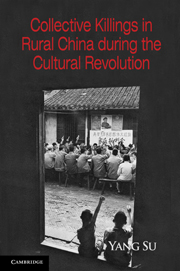Book contents
- Frontmatter
- Contents
- List of Figures
- List of Tables
- Preface and Acknowledgments
- 1 Kill Thy Neighbor
- 2 On the Record
- 3 Community and Culture
- 4 Class Enemies
- 5 Mao's Ordinary Men
- 6 Demobilizing Law
- 7 Framing War
- 8 Patterns of Killing
- 9 Understanding Atrocities in Plain Sight
- Appendix: Methodological Issues and Statistical Analyses
- References
- Index
3 - Community and Culture
Published online by Cambridge University Press: 05 June 2012
- Frontmatter
- Contents
- List of Figures
- List of Tables
- Preface and Acknowledgments
- 1 Kill Thy Neighbor
- 2 On the Record
- 3 Community and Culture
- 4 Class Enemies
- 5 Mao's Ordinary Men
- 6 Demobilizing Law
- 7 Framing War
- 8 Patterns of Killing
- 9 Understanding Atrocities in Plain Sight
- Appendix: Methodological Issues and Statistical Analyses
- References
- Index
Summary
This chapter describes traditional social divisions in the rural communities – traditional because they were shaped by a history of human interactions long before the 1949 communist revolution. As in communities elsewhere, repeated patterns of human conflict generated primary-group boundaries that underpinned the conception of “us versus them,” or in-group and out-group identities. The human imagination must take a “quantum leap” to perceive other people as killable; antagonism toward out-groups is the starting point. These divisions were not sufficient to cause collective killings, but they provided a local impetus for embracing violence when other conditions were in place.
The main unit of organization in the villages of South China was surname lineage. Despite the fact that the 1967–1968 victims were killed under the label “class enemies,” clan identities seemed to be at work. In his report on the 1967 Daoxian massacre, Zhang Cheng describes a scene that implicates clan affiliation in collective killings. Before a killing event, village leaders held a meeting to compile a list of targets. Without exception, villagers nominated and then voted for landlords or rich peasants from their rival clans. My own interviews encountered a similar pattern. In one event, militia members from three main surname lineages called one another's clan members to the stage, where hardwood hoe handles were ready in hand for killing.
- Type
- Chapter
- Information
- Publisher: Cambridge University PressPrint publication year: 2011



